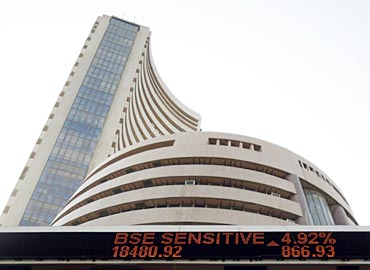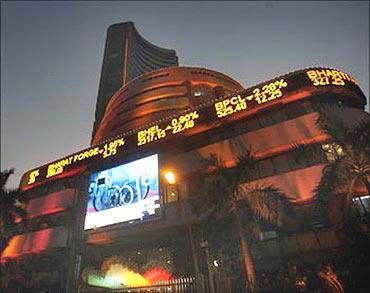 | « Back to article | Print this article |
How to invest in banking stocks
Skyrocketing interest rates, rising non-performing assets, and high deposit rates have beaten down banking sector as a whole. The Bankex -- the index covering all banking stocks -- is lowest in last 18 months. The exchange traded fund, Goldman Sachs Banking Index Exchange Traded Scheme, which tracks banking sector is down to close to 20 per cent in last one year. The performance of PSU sector banks is even worse. They have been down by 30 per cent in last one year.
Could this be the right time to enter into banking stocks?
Click NEXT for more
Note: All these parameters must be seen in totality. Investing in banking stocks based on just one of the few parameters will not be a right approach. The examples of ICICI bank and SBI have been mentioned to clarify the points. Investors should take their own decision regarding investment in these banks.
The author Pankaj Priyadarshi is a financial consultant and can be reached at pankaj@verticalgrass.com. He is B.Tech from IIT, Kharagpur and MBA from ISB, Hyderabad.
How to invest in banking stocks
The current valuation certainly looks attractive from long term perspective. However, RBI has not shown any indication that it will stop raising the policy rates (rising interest rates are generally bad for banking stocks). On the contrary, it has shown resolve to raise the rates further if inflation doesn't stop.
While there will be extreme fluctuation in the short term, the long-term story of Indian economy and banking sector looks good.
Either ways, it will be good for investors to find out how the banks operate and learn about key parameters that impact banking business and thus wealth of investors.
We will study five key parameters that investors need to know before they invest in banking stocks.
Click NEXT for more
How to invest in banking stocks
1. Capital adequacy ratio or CAR
Capital adequacy ratio helps banks manage the risks of default better. The stipulated requirement is 9 per cent to 10 per cent. Most of the banks have it. This is a hygiene factor.
Having it doesn't increase the attractiveness but not having it is lethal for a bank. A higher CAR means the bank is adequately cushioned to expand its loan portfolio when the opportunity arises.
Click NEXT for more
How to invest in banking stocks
2. Net interest margin or NIM
Net interest margin is directly proportional to the difference between the lending rate and the cost of fund.
The cost of fund is nothing but the interest paid to depositors and other borrowings. Typically, a higher interest rate, increases NIM and hence good for banks but this is true to a certain limit.
Once the increase is more frequent, it has reverse effect on NIM.
Since the interest rates have been raised more than 12 times in last two years, this has had adverse effect on NIM of banks.
Typically, NIM of three per cent and more is considered very healthy.
Let's take ICICI bank and SBI for example. NIM of ICICI bank is expected to be 2.6 per cent in FY 2011-2012 while SBI has maintained its NIM at 3 per cent+.
Click NEXT for more
How to invest in banking stocks
3. Price to book or PB ratio
Banks are different from other companies as far as PB ratio is concerned. For companies, PE ratio is more important while PB ratio is the ratio to look at for banks. Their PB ratio revolves between 1 and 2 unlike companies where PB ratio can have meaningless values.
PB ratio of 1 and below 1 shows an attractive bet.
However, most of the large and stable banks have higher PB ratio. Markets put premium on stability and quality of assets of banks.
For example, ICICI bank has a PB ratio of 1.79 while SBI's PB ratio is 1.85. Andhra Bank has PB ratio of 1.03.
Click NEXT for more
How to invest in banking stocks
4. Gross and net non-performing assets
NPAs are bad words for banks. These are the assets or loans that will not be repaid because of various reasons.
Indian banks do not face much problem in NPAs because of their conservative lending practices. However, in last few years, Indian banks have been facing the prospect of higher NPAs and provision. This has happened because of the growth in interest rates where the liabilities of borrowers have gone up by up to 50 per cent in many cases.
The other reason is teaser rate where loans were offered at low rate for initial few years and the same has been raised to market rate increasing the prospect of default by borrowers.
Banks have two types of NPAs: gross and net NPA.
Theoretically, if there is no repayment for last six months, the loan is put into NPA. This is called gross NPA. Banks make provision each year for NPAs. This provision when subtracted from gross NPA gives you the net NPA.
Typically net NPA less than one per cent is no reason to worry about. However, if this goes beyond one per cent, investors expect banks to take measures to correct their lending and recovery processes. Continuing the same example, the net NPA for ICICI bank is 1.6 per cent. SBI bank has net NPA of 1.63 per cent.
Click NEXT for more
How to invest in banking stocks
5. Current account savings account (CASA) ratio
CASA ratio is the amount of deposit from current account and savings account to the total deposit. The CASA ratio is important because this is the source of cheap funds for the banks. A higher CASA ratio reduces the cost of fund for banks and helps increase its net interest income and margin.
This fund can be lent to the borrowers at higher interest rates and banks earn high interest margin on it.
Usually CASA ratio above 40 per cent is considered healthy for banks. The CASA ratio for SBI is 48 per cent while it is 42 per cent for ICICI bank.







